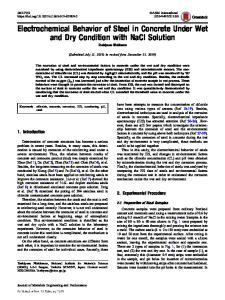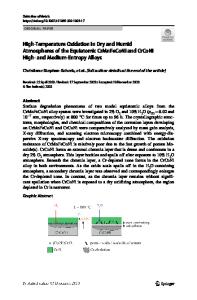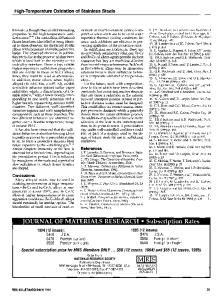High Temperature Oxidation Behavior of APM and APMT under Dry Air/Steam Condition
- PDF / 394,823 Bytes
- 6 Pages / 432 x 648 pts Page_size
- 32 Downloads / 337 Views
High Temperature Oxidation Behavior of APM and APMT under Dry Air/Steam Condition KkochNim Oh1, KwangSup Eom2, Zhiyuan Liang3 and Preet M. Singh1 1 School of Materials Science and Engineering, Georgia Institute of Technology, Atlanta, GA 30332, U.S.A. 2 School of Chemical & Biomolecular Engineering, Georgia Institute of Technology, Atlanta, GA 30332, U.S.A. 3 School of Energy and Power Engineering, Xi’an Jiaotong University, Xi’an 710049, PR China ABSTRACT Oxidation behavior of alumina forming ferritic stainless steel (FeCrAl type stainless steels) grades APM and APMT, which are candidate alloys for fuel cladding, was studied using thermogravimetric analysis under dry air condition, and compared to that of ZIRLO®. In addition to the dry air condition, we also studied the high temperature oxidation behavior of APM and APMT under 100% steam condition in order to compare the effect of environment on the oxidation behavior of these alloys. APM and APMT showed an excellent oxidation resistance at high temperatures compared to ZIRLO® under dry air condition due to a stable Al2O3 oxide scale formed at the surface. Under steam condition, the oxidation rate of APM and APMT was found to be higher compared to that under the dry air condition. INTRODUCTION Light water reactors, which represent the vast majority of nuclear reactors in the world, use Zr-based alloys as fuel cladding material, due to their very low cross-section for thermal neutron absorption coupled with good mechanical properties and corrosion resistance at normal operating conditions [1-4]. However, upon significant temperature increase, these alloys experience significant decrease in strength and tend to burst at temperatures between 700 °C and 1100 °C, depending on the rod’s internal pressure [5]. Therefore, it is important to develop high corrosion resistant cladding materials, with good oxidation resistance under loss of coolant conditions, for replacing current Zr-based alloys. One approach is to use advanced ferritic stainless steels, since they have the potential to overcome some of the limitation of Zr-based alloys such as high temperature strength and high temperature oxidation [6-12]. High temperature oxidation resistance and high temperature strength properties can be easily modified by controlling various alloying elements in ferritic steels in order to satisfy their application performance objectives. Specifically, this study focuses on alumina-forming ferritic stainless steels (FeCrAl type stainless steels) since they were shown to have an excellent oxidation resistance at high temperature compared to Zr-based alloys. Oxidation resistance for these alloys is due to the formation of a stable Al2O3 oxide layer on their surface [7, 13-14]. Brady et al. reported that the alloys with excellent oxidation resistance for long term (>> 1,000 hours), at temperature above 600 ºC, were the ones with alumina (Al2O3) and silica (SiO2) formed at the surface as these oxide scales have sufficiently low diffusion rates of metal and oxygen, resulting in slow growth
Data Loading...










